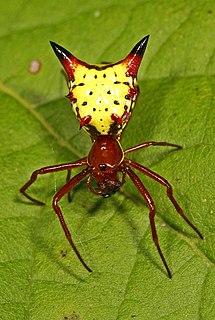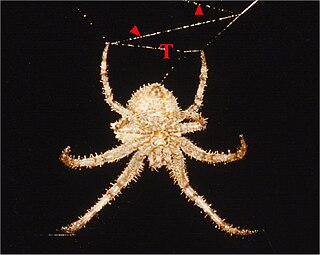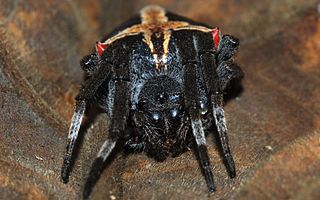
Uloboridae is a family of non-venomous spiders, known as cribellate orb weavers or hackled orb weavers. Their lack of venom glands is a secondarily evolved trait. Instead, they wrap their prey thoroughly in silk, cover it in regurgitated digestive enzymes, and then ingest the liquified body.

Orb-weaver spiders or araneids are members of the spider family Araneidae. They are the most common group of builders of spiral wheel-shaped webs often found in gardens, fields and forest. "Orb" can in English mean "circular", hence the English name of the group. Araneids have eight similar eyes, hairy or spiny legs, and no stridulating organs.

Cyclosa, also called trashline orbweavers, is a genus of orb-weaver spiders first described by Anton Menge in 1866. Widely distributed worldwide, spiders of the genus Cyclosa build relatively small orb webs with a web decoration. The web decoration in Cyclosa spiders is often linear and includes prey remains and other debris, which probably serve to camouflage the spider. The name "Cyclosa" comes from Greek 'to move in a circle', referring to how it spins its web.

Micrathena, known as spiny orbweavers, is a genus of orb-weaver spiders first described by Carl Jakob Sundevall in 1833. Micrathena contains more than a hundred species, most of them Neotropical woodland-dwelling species. The name is derived from the Greek "micro", meaning "small", and the goddess Athena.
Bertrana is a genus of Central and South American orb-weaver spiders first described by Eugen von Keyserling in 1884. It includes some of the smallest known araneid orb-weavers. Bertrana striolata females are 4.5 mm long or less. The eight eyes are in two rows. The abdomen is white on top and on the sides, with multiple hieroglyphic-like lines and bars of many different shapes and length. In females, these are red, in males, black.

Kaira, sometimes called frilled orbweavers, is a mostly neotropical genus of orb-weaver spiders first described by O. Pickard-Cambridge in 1889. It includes sixteen described species that occur from South America up to the southern and eastern USA. It is presumably related to Aculepeira, Amazonepeira and Metepeira.

Glenognatha is a genus of long-jawed orb-weavers that was first described by Eugène Louis Simon in 1887. It was considerably revised in 2016.

Parawixia is a genus of orb-weaver spiders first described by F. O. Pickard-Cambridge in 1904. Most species are found in the Neotropics but one species, Parawixia dehaani, is found in Australasia and tropical Asia as far west as India.
Dubiepeira is a genus of South American orb-weaver spiders first described by Herbert Walter Levi in 1991.
Enacrosoma is a genus of orb-weaver spiders first described by Cândido Firmino de Mello-Leitão in 1932.
Hingstepeira is a genus of South American orb-weaver spiders first described by Herbert Walter Levi in 1995.
Hypognatha is a genus of orb-weaver spiders first described by F. E. Guérin-Méneville in 1839.
Kapogea is a genus of orb-weaver spiders first described by Herbert Walter Levi in 1997.
Lewisepeira is a genus of orb-weaver spiders first described by Herbert Walter Levi in 1993.

Mecynogea is a genus of orb-weaver spiders first described by Eugène Simon in 1903. The name is derived from the Greek mekyno (μηυνω), meaning "to lengthen", and "gea" (γεα), meaning "earth".
Metazygia is a genus of orb-weaver spiders first described by F. O. Pickard-Cambridge in 1904. They physically resemble members of Nuctenea, but they do not have fine setae on the carapace.
Micrepeira is a genus of orb-weaver spiders first described by E. Schenkel in 1953.
Pronous is a genus of South American and African orb-weaver spiders first described by Eugen von Keyserling in 1881.
Spinepeira is a genus of South American orb-weaver spiders containing the single species, Spinepeira schlingeri. It was first described by Herbert Walter Levi in 1995, and has only been found in Peru.
Wagneriana is a genus of orb-weaver spiders first described by F. O. Pickard-Cambridge in 1904.







